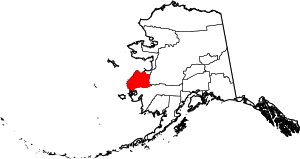Pitkas Point, Alaska
| Pitkas Point Negeqliim Painga | |
|---|---|
| CDP | |
|
Location of Pitkas Point, Alaska | |
| Coordinates: 62°2′8″N 163°15′39″W / 62.03556°N 163.26083°WCoordinates: 62°2′8″N 163°15′39″W / 62.03556°N 163.26083°W | |
| Country | United States |
| State | Alaska |
| Census Area | Kusilvak |
| Government | |
| • State senator | Donald Olson (D) |
| • State rep. | Neal Foster (D) |
| Area | |
| • Total | 1.5 sq mi (3.9 km2) |
| • Land | 1.5 sq mi (3.9 km2) |
| • Water | 0.0 sq mi (0.0 km2) |
| Population (2000) | |
| • Total | 123 |
| • Density | 83.9/sq mi (32.4/km2) |
| Time zone | Alaska (AKST) (UTC-9) |
| • Summer (DST) | AKDT (UTC-8) |
| Area code | 907 |
| FIPS code | 02-60860 |
Pitkas Point (Negeqliim Painga in Central Yup'ik) is a census-designated place (CDP) in Kusilvak Census Area, Alaska, United States. The population was 125 at the 2000 census.
Geography
Pitkas Point is located at 62°2′8″N 163°15′39″W / 62.03556°N 163.26083°W (62.035485, -163.260857).[1]
According to the United States Census Bureau, the CDP has a total area of 1.5 square miles (3.9 km2), all of it land.
Demographics
As of the census[2] of 2000, there were 125 people, 30 households, and 24 families residing in the CDP. The population density was 83.9 people per square mile (32.4/km²). There were 42 housing units at an average density of 28.2/sq mi (10.9/km²). The racial makeup of the CDP was 6.40% White, 91.20% Native American, and 2.40% from two or more races.
There were 30 households out of which 56.7% had children under the age of 18 living with them, 56.7% were married couples living together, 13.3% had a female householder with no husband present, and 20.0% were non-families. 20.0% of all households were made up of individuals and 3.3% had someone living alone who was 65 years of age or older. The average household size was 4.17 and the average family size was 4.92.
In the CDP the population was spread out with 46.4% under the age of 18, 8.8% from 18 to 24, 26.4% from 25 to 44, 15.2% from 45 to 64, and 3.2% who were 65 years of age or older. The median age was 22 years. For every 100 females there were 101.6 males. For every 100 females age 18 and over, there were 109.4 males.
The median income for a household in the CDP was $41,875, and the median income for a family was $46,250. Males had a median income of $26,250 versus $21,250 for females. The per capita income for the CDP was $10,488. There were 40.0% of families and 32.2% of the population living below the poverty line, including 33.3% of under eighteens and 57.1% of those over 64.
References
- ↑ "US Gazetteer files: 2010, 2000, and 1990". United States Census Bureau. 2011-02-12. Retrieved 2011-04-23.
- ↑ "American FactFinder". United States Census Bureau. Retrieved 2008-01-31.
